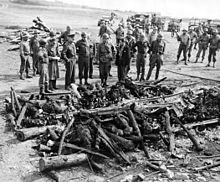Ohrdruf Forced Labor Camp
The Ohrdruf forced labor camp , also known as “ Ohrdruf-Nord” , was set up in Ohrdruf , about 13 kilometers south of Gotha , as a satellite camp of the Buchenwald concentration camp towards the end of 1944 .
The prisoners were used to build extensive underground tunnels and bunkers. In March 1945 the camp had 11,700 prisoners. The barracks, painted green for camouflage, were fenced in with two rows of barbed wire.
history
Prior use of the area
Since 1871, an area between Ohrdruf, Jonastal and Bittstädt has been used as a maneuvering area, so that in 1906 the establishment of an official military training area was decided by the Reichstag and the expansion of the area began in 1908.
Since 1938, the Reichspost operated a secret telecommunications control system for the Wehrmacht under the code name Amt-10 .
Established as a prisoner of war camp
In 1941/1942 a small camp for Soviet prisoners of war was set up. In autumn 1944 the SS took over parts of the camp. The SS set up an Ohrdruf S III external command of the Buchenwald concentration camp on the camp grounds . The camp existed from November 6, 1944 to the beginning of April 1945. It should be noted as a special feature that it was run as an independent concentration camp from November 14, 1944 to January 15, 1945 and was not part of the Buchenwald population - like all other subcamps. In addition to the north and south camps at Ohrdruf, S III also included the other camps in the air ammunition facility (LMunA) Crawinkel and the so-called tent camp near Espenfeld .
The construction of the camp is related to the planned construction of tunnels near Jonastal. Allegedly the prisoners were supposed to build an underground headquarters for Hitler from November 1944 . However, this information is not adequately documented and the intended function of the tunnels near Jonastal is unclear.
On January 30, 1945, 1,000 forced laborers were sent on a death march to the Bergen-Belsen concentration camp , which many did not survive.
Death march to Buchenwald
On April 2, 1945, most of the prisoners had to march 51 kilometers to Buchenwald under SS guard in another death march. The number of prisoners who collapsed and died during the march or were shot by the SS guards can only be estimated.
In addition to the 60 to 70 dead who had apparently been slain or shot before the march because they did not seem fit to march, there were some survivors who were able to hide from the SS guards and thus escape being abducted again. Prisoners who escaped from the march, including Andrew Rosner, were able to lead US troops to the camp.
The guards tried to burn as many of the 3,200 dead as possible on open fires before they escaped. There was no crematorium in this camp.
liberation
On April 5, 1945, the training area was captured by the 4th US Armored Division , which set up a transit camp in Ohrdruf for released Soviet prisoners of war.
It was the first liberated camp with surviving prisoners who could provide information about their fate. Ohrdruf Forced Labor Camp was visited on April 12 by US Generals George S. Patton , Omar N. Bradley , and Dwight D. Eisenhower . Eisenhower describes this visit as a shock in his diary. He was also shown the gallows on which executions with piano strings took place. On the same day, he visited the salt mine in which National Socialist assets were stored.
Use of the area by the Soviet Army
From 1947 the Soviet army used the training area until it was handed over to the Federal Ministry of Defense in 1991 .
Handover to the Bundeswehr
In December 1993 the place was taken over by the Bundeswehr . However, the area was left neglected by the Russian armed forces: Dilapidated buildings, garbage dumps and piles of rubble, contaminated waters, contaminated areas and numerous non-effective weapons made and still make the clean-up work a tedious process today.
See also
- Crawinkel subcamp (after one week of fighting, Crawinkel was occupied by the Americans), Arnstadt , code names of Nazi secret objects (S III), Jonastal tunnel
- List of the Buchenwald subcamps
- List of memorials for the victims of National Socialism
- Military training area / POW camp in Ohrdruf
Web links
- American War Information Office on behalf of the Commander in Chief of the Allied Forces: KZ - Photo report from five concentration camps Created around April 1945. Reconstruction by VVN-BdA NRW 2006 ( PDF file )
- Listed cemeteries of honor u. a. for the concentration camp prisoners in Thuringia on mdr.de (figures for the individual locations)
- The project S lll and Olga ( Memento from May 4, 2005 in the Internet Archive )
- List of concentration camps and their external commandos in accordance with Section 42 (2) BEG
- "Nazi Concentration Camps" on archives.org - recordings of the liberated camp and the visit of the US military from 8.10 min
Individual evidence
- ↑ SEIDLER, Francis W., Zeigert, Dieter Leaders Headquarters , 2000, published by FA Herbig, Munich, ISBN 3-7766-2154-0
- ^ Intelligence and reconnaissance (I & R) platoon, attached to the Headquarters company of the 354th Infantry Regiment, the 89th Infantry Division, Third US Army
Coordinates: 50 ° 50 ′ 1 ″ N , 10 ° 45 ′ 17 ″ E


